Cluster helps solve mysteries of geomagnetic storms
4 March 2019
In a powerful example of combining multi-mission satellite data with computer simulations, scientists have used ESA's Cluster mission to reveal details about how electrons interact with waves in Earth's magnetic environment. This research helps explain the behaviour of particles during geomagnetic storms and has significant implications for our understanding of space weather, which is in turn necessary to help protect space technology from the potentially harmful effects of energetic particles generated during such storms.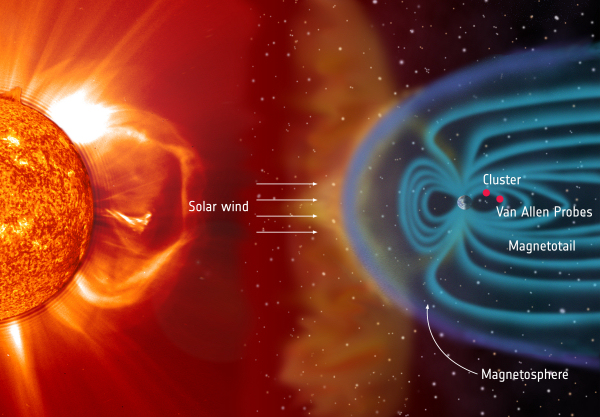 |
| Cluster and the Van Allen Probes in Earth's magnetosphere. Credit: ESA/NASA/SOHO/LASCO/EIT |
The Sun constantly bombards Earth with a flow of charged particles known as the solar wind. Powerful shocks arising in this flow can cause disturbances in Earth's magnetosphere – the protective bubble created by our planet's magnetic field – which are known as geomagnetic storms.
These storms transfer a large amount of energy to the magnetosphere, eventually causing electrons to accelerate along magnetic field lines, which are continuous curves indicating the magnetic field direction, extending between the poles of our planet. When these electrons enter the ionosphere – the upper layer of Earth's atmosphere – the resulting interaction causes atoms like nitrogen and oxygen to release light, leading to the beautiful displays known as the aurora. The most energetic electrons can also cause serious damage to satellites and other electronic infrastructure.
For a long time, the detailed mechanisms behind the movement of electrons between the magnetosphere and the ionosphere remained a mystery. But recently a team of scientists discovered that certain types of oscillations in Earth's magnetic field can explain some intriguing observations of how electrons behave along magnetic field lines.
As the solar wind varies in speed and intensity, bursts of plasma can be fired from the magnetotail, in the opposite direction to the Sun, towards Earth, through a process known as magnetic reconnection. When these fast plasma streams reach Earth, they impact high-pressure plasma on the magnetic field lines. This causes the magnetic field lines to vibrate, giving rise to standing waves – also known as Alfvén waves – oscillating perpendicular to the dipolar magnetic field lines.
Akin to waves on a guitar string, these oscillations occur on a range of scales, including small-scale waves comparable to the orbits of particles moving along the field lines. In this case, these waves are called Kinetic-Scale Field Line Resonances (KFLRs) and, while always present in the magnetosphere, they are enhanced when magnetic storms on the Sun send highly energetic solar wind flows towards Earth, triggering a geomagnetic storm.
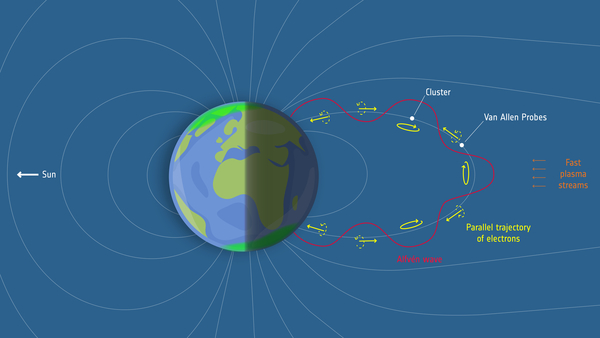 |
| Electrons trapped in kinetic scale field line resonance. Credit: ESA |
Studying observations of Earth's magnetic field taken on different occasions by ESA's Cluster mission and NASA's Van Allen Probes, a team of scientists noticed that, in both sets of data, the distribution of electrons within these waves was stretched following the direction of magnetic field lines from the North Pole to the South Pole.
However, the detailed structure of the distributions was different in the two sets of observations, which were taken at significantly different points along the magnetic field. The Van Allen Probes observations were performed in June 2013 during a geomagnetic storm; the Cluster observations, dating back to February 2001, were obtained in storm-like circumstances, under enhanced auroral conditions.
To investigate the nature of the electron distributions and the differences in the details seen by the two missions, the scientists brought in a computer simulation.
"I had created the computer model to study the interaction of electrons within magnetospheric Alfvén waves, and these observations provided us with the first opportunity to look specifically at kinetic-scale field line resonances in the inner magnetosphere," explains project lead Peter Damiano from the University of Alaska Fairbanks, USA.
"We were surprised to find that the simulations reproduced the characteristics of the observations from both missions very well. And when we compared the observations and the simulations, it became clear that the stretching of the electron distribution in the direction of Earth's magnetic field was caused, in both cases, by the trapping of electrons within the KFLRs."
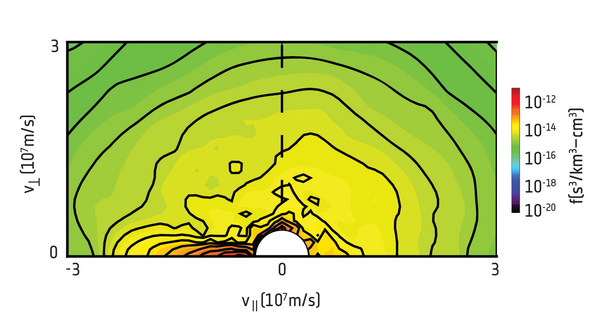 |
| Cluster measurement of electron distribution function. Credit: ESA/Cluster; P. Damiano et al. (2018) |
Since the KFLRs evolve over time, so does the trapped electron population, and this explains the difference between the observations by the two missions. The Cluster data demonstrated more clearly how the distribution changes over time, because observations were made every four seconds – similar to the oscillation period of the waves. The Van Allen Probes data, on the other hand, were taken every eleven seconds, so the distribution of electrons was smoothed out and it was more difficult to see how it changed over time. As the spacecraft took measurements while in different locations, the study also revealed that electrons could be trapped at different points along the magnetic field lines because of the global extent of the waves. This illustrates how the simulations help scientists connect and understand seemingly remote observations.
Being closer to the ionosphere, the Cluster observations of electron distribution functions also illustrated the significant loss of electrons from the magnetosphere to ionosphere – which can contribute to the generation of auroral emissions at high altitudes. The simulations showed that this loss might be due to the interaction of KFLRs with non-trapped electrons.
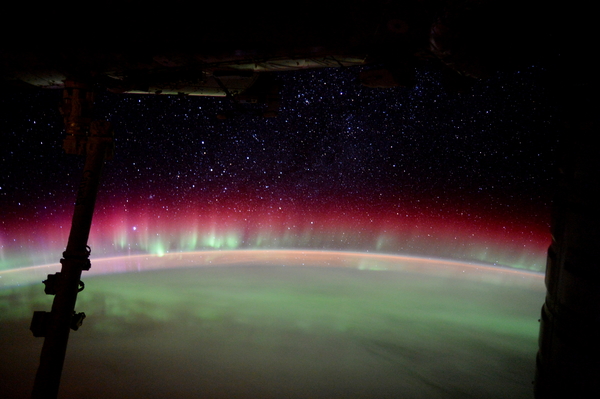 |
| High-altitude red aurora observed from the International Space Station. Credit: ESA/NASA |
Although scientists have a good idea of how the magnetosphere works overall, many specific details are still unclear, and this study is one step towards furthering our understanding.
"Our ultimate goal is to understand magnetospheric processes well enough to forecast how particles behave around Earth, including predicting the locations of the most dangerous geomagnetic storms," explains Philippe Escoubet, Cluster mission scientist.
"This would help us to forecast the impact of the energetic particle environment around Earth on all sorts of technological infrastructure."
During geomagnetic storms, KFLRs are enhanced, modifying the distributions of particles in the Van Allen radiation belts – two doughnut-shaped regions of highly energetic charged particles surrounding Earth. These changes to the plasma can impact other electromagnetic waves that are linked to the acceleration of very high-energy electrons, and consequently the response of the magnetosphere during geomagnetic storms.
"Elucidating how electrons interact with KFLRs during such storms is vital for understanding and predicting space weather," continues Damiano.
Space weather refers to the variable solar conditions that can influence our planet's surroundings, with effects on the performance of human technology on ground and in space. As spacecraft electronics can be severely affected by highly-energetic charged particles, especially at times of strong geomagnetic activity, it is vital to recognise the impact of magnetospheric processes on satellite infrastructure, and science missions like Cluster and the Van Allen Probes are crucial to these efforts.
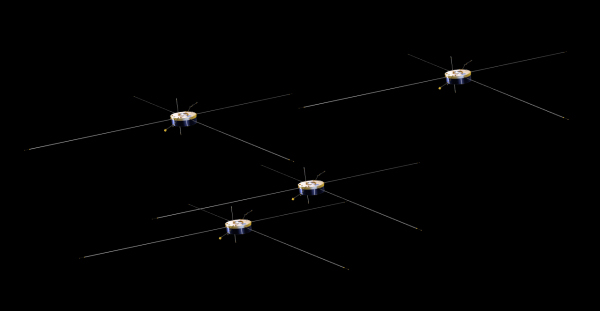 |
| Artist's impression of the Cluster spacecraft. Credit: ESA/ATG medialab |
"If we can accurately forecast when geomagnetic storms occur, we can take measures such as switching off spacecraft electronics to avoid short-circuiting, and flying aeroplanes around storms to prevent excess radiation exposure to crew and passengers," continues Escoubet.
"Space weather can also affect GPS signals and better understanding its impacts would help us generate more accurate location data."
Launched in 2000, Cluster has helped unearth a plethora of interesting details about the magnetosphere and its interaction with the solar wind. The mission's four spacecraft can access high latitudes above our planet, providing new and unprecedented measurements of the magnetosphere.
This result highlights how combining data from more than one mission allows us to study magnetospheric phenomena in a totally new way. It also demonstrates the richness of the Cluster and Van Allen Probe data archives and their combined potential to make new discoveries with far-reaching applications.
Notes for Editors
"Electron Distributions in Kinetic Scale Field Line Resonances: A Comparison of Simulations and Observations" by P.A. Damiano et al (2018) is published in Geophysical Research Letters. DOI: 10.1029/2018GL077748
Cluster is a constellation of four spacecraft flying in formation around Earth. It is the first space mission able to study, in three dimensions, the natural physical processes occurring within and in the near vicinity of the Earth's magnetosphere. Launched in 2000, it is composed of four identical spacecraft orbiting the Earth in a pyramidal configuration, along a nominal polar orbit of 4 × 19.6 Earth radii (1 Earth radius = 6380 km). Cluster's payload consists of state-of-the-art plasma instrumentation to measure electric and magnetic fields over wide frequency ranges, and key physical parameters characterising electrons and ions from energies of near 0 eV to a few MeV. The science operations are coordinated by the Joint Science Operations Centre (JSOC) at the Rutherford Appleton Laboratory, United Kingdom, and implemented by ESA's European Space Operations Centre (ESOC), in Darmstadt, Germany.
More information on the Cluster mission can be found here.
NASA's Van Allen Probes (formerly known as the Radiation Belt Storm Probes, RBSP) study two extreme and dynamic regions of space known as the Van Allen Radiation Belts that surround Earth. Named for their discoverer, James Van Allen, these two concentric, doughnut-shaped rings are filled with high-energy particles that gyrate, bounce, and drift through the region, sometimes shooting down to Earth's atmosphere, sometimes escaping out into space. The radiation belts swell and shrink over time as part of a much larger space weather system driven by energy and material that erupt off the sun's surface and fill the entire solar system.
More information on the Van Allen Probes can be found here.
For further information, please contact:
Peter A. Damiano
Geophysical Institute
University of Alaska Fairbanks
Fairbanks, AK, USA
Email: padamiano![]() alaska.edu
alaska.edu
Philippe Escoubet
Cluster Project Scientist
European Space Agency
Email: Philippe.Escoubet![]() esa.int
esa.int




